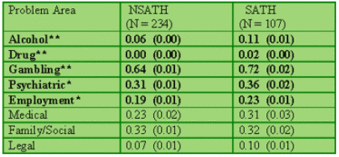The WAGER Vol. 8(44) – Learning from History: Prior Substance Abuse Treatment
Researchers have demonstrated high rates of substance abuse among pathological gamblers (see WAGER 8(13)). Because co-occurring gambling related problems and substance abuse is common, it is important to understand how current and past substance abuse might influence gambling behavior and treatment. To this end, Ladd and Petry (Ladd & Petry, 2003) compared pathological gamblers with and without substance abuse treatment histories (SATH) and found they differed on many important dimensions.
The researchers recruited gamblers from 350 consecutive admissions to two gambling treatment programs. Of the 341 gamblers who agreed to participate, 208 were entering a state-funded gambling treatment program and 133 were entering a cognitive-behavioral treatment study. Both programs drew their clients from advertisements and referrals. Although not an inclusion criterion, all participants scored 5 or greater on the South Oaks Gambling Screen (SOGS, Lesieur & Blume, 1987), indicating they all screened positive for having a pathological gambling disorder. Trained interviewers administered the Addiction Severity Index (ASI, Lesieur & Blume, 1991; McLellan & et al., 1985) to the participants. The ASI assesses the severity of eight problem areas associated with addiction. Composite ASI scores are calculated for each problem area and range from 0.00, no problem, to 1.00, the most severe problem level. ASI scores were adjusted to control for gender, income and recruitment site. Researchers determined substance abuse treatment history by asking participants if they had ever received professional treatment or engaged in a 12-step program for alcohol or drug abuse.
Not surprisingly, participants with a substance abuse treatment history (SATH) evidenced more severe current alcohol and drug problems (Table 1); what is more interesting is that they also evidenced more severe gambling, psychiatric, and employment problems. In addition to scoring higher on the gambling portion of the ASI, participants with a substance abuse history scored significantly higher on the SOGS (mean scores of 13.4 and 11.9 respectively; F(1,316)=9.76, p<.01), experienced gambling problems for more years (mean scores of 10.7 and 7.1 respectively; F(1,318)=11.84, p<.001), and gambled more days in the last month (mean scores of 15.4 and 10.6 respectively; F(1,321)=11.59, p<.01). In addition, compared to those without, twice as many people with a SATH were currently receiving psychological treatment (32.3% versus 14.6%). The difference in employment problems was a result of more missed days of work in the last month due to gambling (4.9 versus 2.1 days; F(1, 186)=8.03, p<.01).
Table 1. Adjusted Mean (S.D.) ASI Composite Scores (Ladd & Petry, 2003)
**p<.01, *p<.05
Although the investigators identified statistically significant differences between participants with and without a substance abuse history, these differences might not be clinically significant. Not all problems that screen positively are associated with clinically meaningful difficulties (e.g., Narrow, Rae, Robins, & Regier, 2002). Slight differences in the extent of serious adverse consequences might not be enough to influence treatment seeking behavior or treatment outcome. Another limitation of the study is that the investigators used past substance abuse treatment as a proxy for past substance abuse problems. By measuring only professional treatment and engagement in12-step programs, they fail to capture people who sought help through other avenues, such as from friends or clergy. Additionally, many people recover from substance abuse problems without treatment (i.e., natural recovery)(Sobell, Cunningham, & Sobell, 1996; Sobell, Ellingstad, & Sobell, 2000) and thus past treatment involvement might not be a good measure of past substance abuse. In this study, people with past substance abuse problems who did not seek treatment were grouped with people who have never had substance abuse problems. The differences reported between the two treatment groups might therefore be a conservative estimate of the difference between patients with and without past substance abuse problems.
This research indicates that a history of substance abuse treatment is associated with an increased severity of gambling, substance use and psychological problems among patients presenting for gambling treatment. Treatment providers should be aware that a past history of substance abuse could indicate that their patient also is grappling with underlying psychosocial problems and substance abuse. In practice, these patients require a comprehensive assessment and a multi-focused treatment approach that is sensitive to these issues.
Comments on this article can be addressed to Rachel Kidman.
References
Ladd, G. T., & Petry, N. M. (2003). A Comparison of Pathological Gamblers With and Without Substance Abuse Treatment Histories. Experimental & Clinical Psychopharmacology, 11(3), 202-209.
Lesieur, H. R., & Blume, S. B. (1987). The South Oaks Gambling Screen (SOGS): A new instrument for the identification of pathological gamblers. American Journal of Psychiatry, 144(9), 1184-1188.
Lesieur, H. R., & Blume, S. B. (1991). Evaluation of patients treated for pathological gambling in a combined alcohol, substance abuse and pathological gambling treatment unit using the Addiction Severity Index. British Journal of Addiction, 86, 1017-1028.
McLellan, A. T., Luborsky, L., Cacciola, J., Griffith, J., Evans, F., Barr, H. L., et al. (1985). New data from the Addiction Severity Index: Reliability and validity in three centers. Journal of Nervous & Mental Disease, 173(7), 412-423.
Narrow, W. E., Rae, D. S., Robins, L. N., & Regier, D. A. (2002). Revised prevalence estimates of mental disorders in the United States. Archives of General Psychiatry, 59, 115-123.
Sobell, L. C., Cunningham, J. A., & Sobell, M. B. (1996). Recovery from alcohol problems with and without treatment: Prevalence in two population surveys. American Journal of Public Health, 86(7), 966
972.
Sobell, L. C., Ellingstad, T. P., & Sobell, M. B. (2000). Natural recovery from alcohol and drug problems: Methodological review of the research with suggestions for future directions. Addiction, 95(5), 749-764.
